Discover 7 hidden attractions, cool sights, and unusual things to do in Glacier Bay National Park (United States). Don't miss out on these must-see attractions: Mount Abdallah, Mount Bertha, and Mount Abbe. Also, be sure to include Mount Merriam in your itinerary.
Below, you can find the list of the most amazing places you should visit in Glacier Bay National Park (Alaska).
Table of Contents
Mount Abdallah
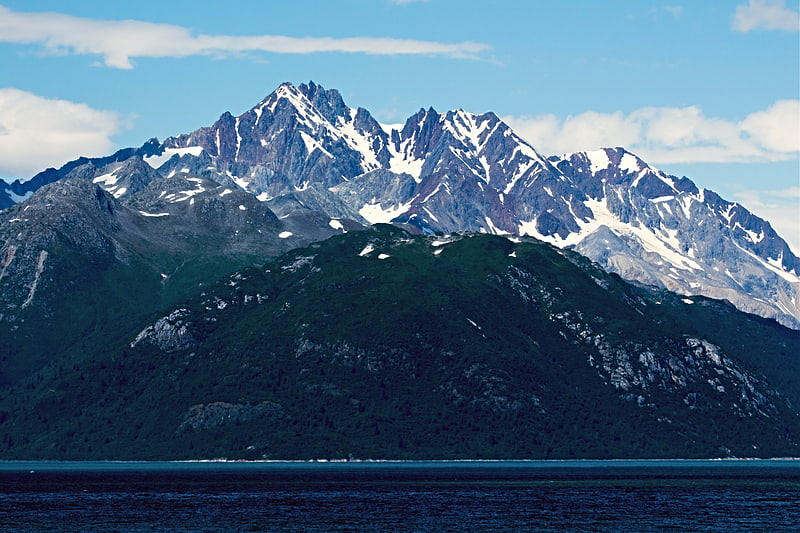
Mount Abdallah is a prominent 6,210-foot mountain summit located in the Alsek Ranges of the Saint Elias Mountains, in southeast Alaska. The mountain is situated in Glacier Bay National Park and Preserve, as the highest point between Tarr Inlet and Rendu Inlet, 93 mi northwest of Juneau, and 10.5 mi southeast of Mount Barnard, which is the nearest higher peak. Although modest in elevation, relief is significant since the mountain rises up from tidewater in less than three miles. The mountain was named in 1892 by Harry Fielding Reid, an American geophysicist, who in 1892 hired a small crew of men for an expedition to study glaciology in Glacier Bay. There is no record of who Reid named this mountain for, but a member of his expeditionary crew who accompanied him might be a possibility. The months May through June offer the most favorable weather for viewing Mount Abdallah. Weather permitting, Mount Abdallah can be seen from Glacier Bay, which is a popular destination for cruise ships.[1]
Mount Bertha
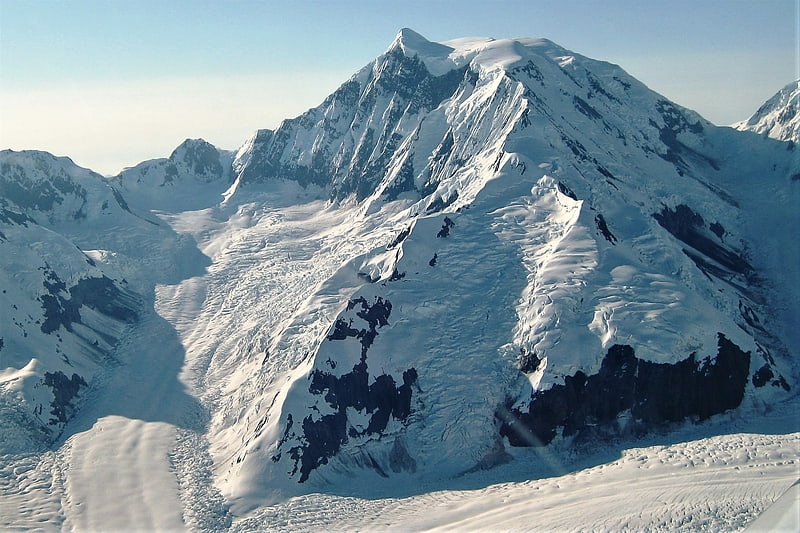
Mount Bertha is a 10,204-foot glaciated mountain summit located in the Fairweather Range of the Saint Elias Mountains, in southeast Alaska, United States. The peak is situated in Glacier Bay National Park, 5.5 mi east-northeast of Mount Crillon which is the nearest higher peak, and 23.5 mi southeast of Mount Fairweather, which is the highest peak in the Fairweather Range. The mountain's name first appeared in 1910 when published by U.S. Coast and Geodetic Survey. The USGS claims it was named after S.S. Bertha, an Alaska Commercial Company steamer in service from 1888 until it wrecked at Uyak Bay on July 18, 1915. However, according to Bradford Washburn of the Boston Museum of Science and American Mountaineering Museum, this feature was named for a prostitute in Skagway known by members of the International Boundary Commission who surveyed the area. The first ascent of the peak was made July 30, 1940, by Bradford Washburn, his wife Barbara Washburn, Maynard Miller, Michl Feuersinger, and Thomas Winship. It was the first mountain climbing experience for Barbara, and Bradford would later refer to the expedition as their honeymoon since they had recently married in April. After the expedition she would learn that she was several months pregnant. In 1947 she became the first woman to summit Denali. The months May through June offer the most favorable weather for climbing and viewing.[2]
Mount Abbe
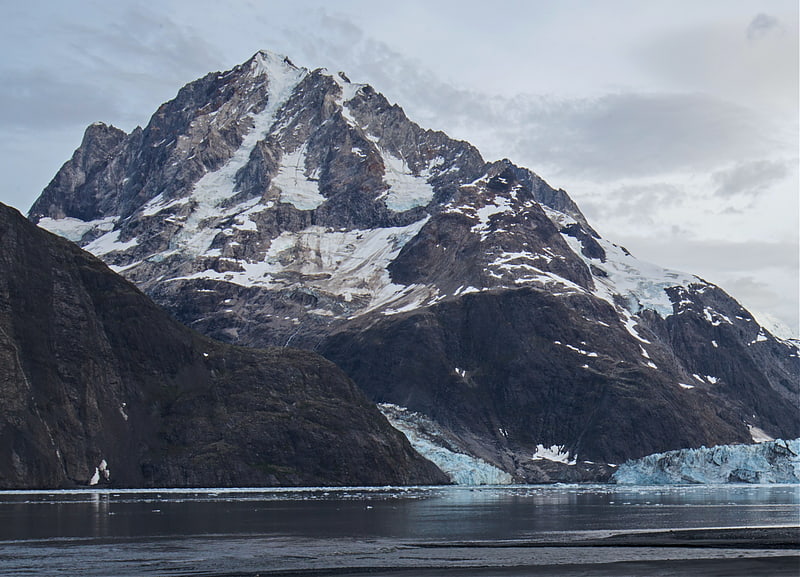
Mount Abbe is an 8200+ feet double summit mountain located in the Fairweather Range of the Saint Elias Mountains, in southeast Alaska. The peak is situated near the terminus of the Johns Hopkins Glacier, within Glacier Bay National Park and Preserve, 100 mi northwest of Juneau, and 8.2 mi northeast of Mount Orville. Although modest in elevation, relief is significant since the mountain rises up from tidewater in less than two miles. Mount Abbe is often seen and photographed with the Johns Hopkins Glacier, which is a popular destination for cruise ships. The mountain was named in 1936 by William Osgood Field and William Skinner Cooper, of the American Geographical Society, for Cleveland Abbe Jr. an American geographer. Abbe received a Ph.D. in 1898 from Johns Hopkins University. The Gilman Glacier and Clark Glacier on the mountain's slopes were named for Daniel Coit Gilman, the institution's first president, and William Bullock Clark who was a professor of geology at the university. The mountain's name was officially adopted in 1937 by the United States Geological Survey. The first ascent of the south summit was made June 11, 1977, by Jim Wickwire and Dusan Jagersky via the Southeast Face. Three days later, Dusan Jagersky was tragically killed while descending an unnamed peak. The first ascent of the north summit was made July 14, 1991, by Walter Gove and William Pilling. The months May through June offer the most favorable weather for climbing Mount Abbe, but it's a challenging climb in any conditions, with few attempts.[3]
Mount Merriam
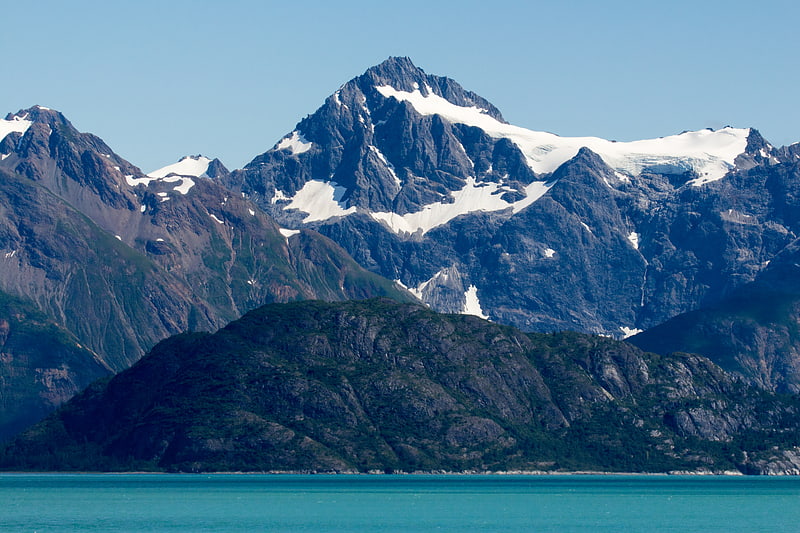
Mount Merriam is a prominent 5,083-foot mountain summit located in Glacier Bay National Park and Preserve, in the Alsek Ranges of the Saint Elias Mountains, in southeast Alaska. The mountain is situated 75 mi northwest of Juneau, 3.1 mi south of Mount Wordie, 3.5 mi north of Black Cap Mountain, and 13.4 mi southeast of Mount Abdallah which is the nearest higher peak. Although modest in elevation, relief is significant as the mountain rises up from tidewater in less than three miles, and it ranks 85th in prominence for all peaks in Alaska.
The mountain was named by members of a 1941 Glacier Bay expedition for Dr. Clinton Hart Merriam (1855-1942), Chief of the U.S. Department of Agriculture (USDA) Biological Survey. Merriam was a zoologist for the 1899 Harriman Alaska expedition which explored Glacier Bay. Weather permitting, Mount Merriam can be seen from Glacier Bay, which is a popular destination for cruise ships. The months May through June offer the most favorable weather for viewing or climbing the peak.[4]
Mount Wordie
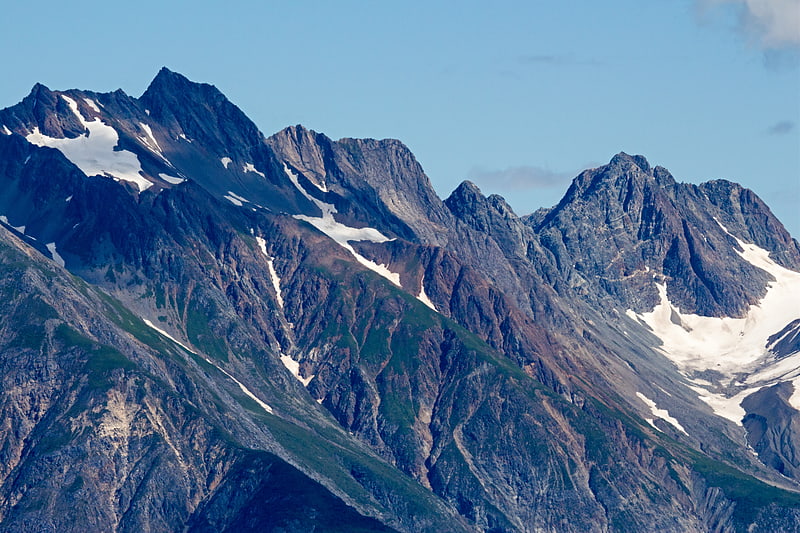
Mount Wordie is a 4,700+ foot mountain summit located in Glacier Bay National Park and Preserve, in the Alsek Ranges of the Saint Elias Mountains, in southeast Alaska. The mountain is situated 80 mi northwest of Juneau, 4 mi south of Carroll Glacier, and 3.1 mi north of Mount Merriam which is the nearest higher peak. Although modest in elevation, relief is significant as the mountain rises up from tidewater in less than two miles.
The mountain was named by members of a 1941 Glacier Bay expedition for James Mann Wordie (1889-1962), a Scottish polar explorer, glacier geologist, and President of the Royal Geological Society from 1951 through 1954. Wordie visited nearby Muir Glacier in Glacier Bay in 1913. Weather permitting, Mount Wordie can be seen from Queen Inlet and Wachusett Inlet of Glacier Bay, which is a popular destination for cruise ships. The months May through June offer the most favorable weather for viewing or climbing the peak.[5]
Black Cap Mountain
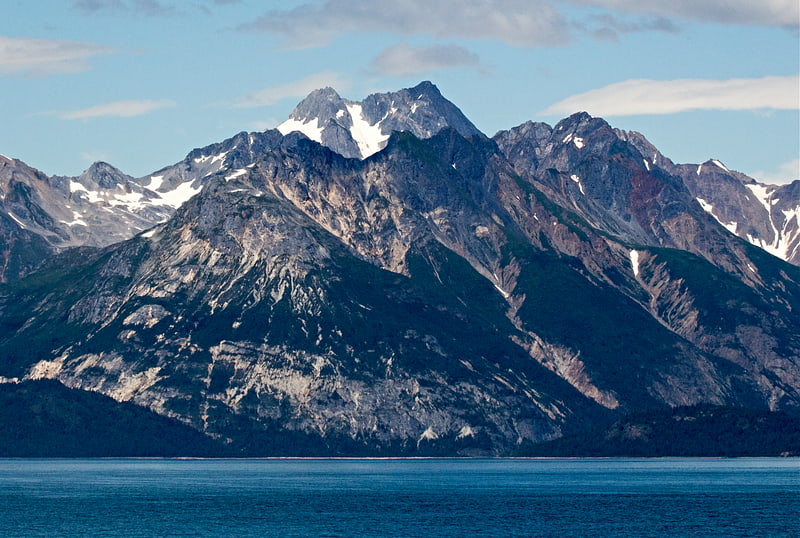
Black Cap Mountain is a 3,321-foot mountain summit located in Glacier Bay National Park and Preserve, in the Alsek Ranges of the Saint Elias Mountains, in southeast Alaska. The mountain is situated immediately north of the entrance to Tidal Inlet, 80 mi northwest of Juneau, and 3.5 mi south of Mount Merriam, which is the nearest higher peak. Although modest in elevation, relief is significant as the mountain rises up from tidewater in less than two miles. The mountain's descriptive name was given by the U.S. Geological Survey in 1956 because the summit is composed of black limestone which contrasts with the color of the flanks of the mountain, making it visible for many miles. The mountain's name was officially adopted in 1960 by the U.S. Board on Geographic Names. Weather permitting, Black Cap Mountain can be seen from Glacier Bay, which is a popular destination for cruise ships. The months May through June offer the most favorable weather for viewing or climbing the peak.[6]
Spirit of Glacier Bay

Spirit of Glacier Bay, formerly Spirit of Nantucket and Nantucket Clipper, and now called the Chichagof Dream is a small cruise ship that was owned and operated by Cruise West until 2010. She is 207 feet long, carries up to 102 passengers and approximately 28 crew. It was built in 1984 at Jeffersonville, Indiana for Clipper Cruise Lines by Jeffboat Corporation, and operated on the East Coast of North America, from the Caribbean Sea to the Canadian Maritimes and into the Great Lakes as far as Chicago. In 2006, Nantucket Clipper, along with fleet-mate Yorktown Clipper, was purchased by Seattle-based Cruise West. Nantucket Clipper was renamed Spirit of Nantucket at this time. In 2006 and 2007 she continued operating on her usual routes.[7]